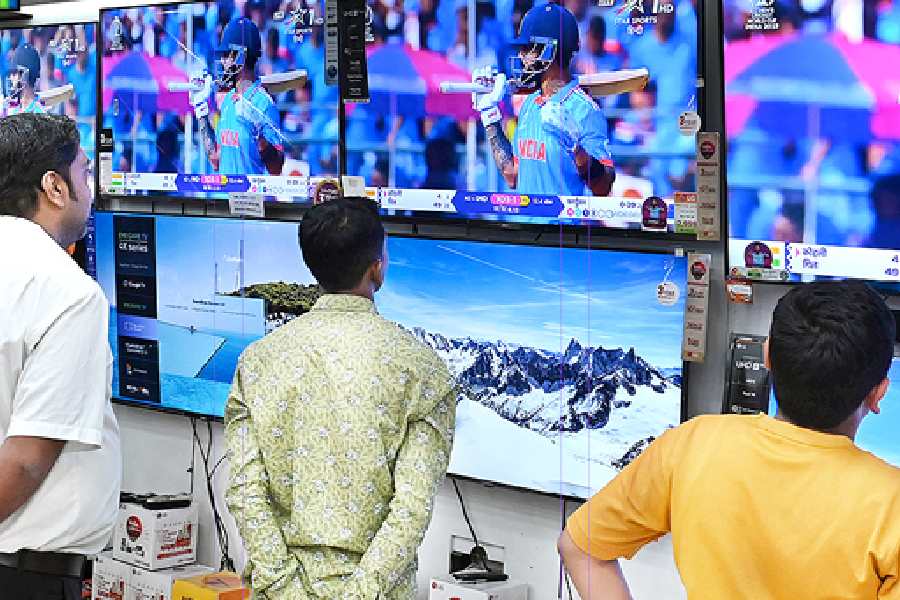King Kohli mesmerised many summitting Mount Fifty with a cracking innings in Mumbai. Nearly 2,000km away in Calcutta, that was a reason to light crackers banned by law.
Many Calcuttans said they were startled by the frequency of the explosions, and those were not as pleasant to the ear as Shreyas Iyer’s sixes were to the eye.
When New Zealand came out to bat, crackers burst with each wicket falling. And then there was a period of quiet. But then the Kali Puja processions started and many localities again reported loud noise.
“I heard sounds of crackers from the time Kohli reached the 90s. It continued and peaked when he reached the 100-mark,” said a Behala resident.
A resident of Sovabazar Hatkhola said he had been hearing the sound of crackers since late afternoon. “I will say the sound was as much as Diwali. Many Kali Puja immersions were scheduled for Wednesday. The crackers that burst were for the immersion as well as the cricket match,” said the Sovabazar resident.
Residents of Ballygunge, Hazra, Tiljala and Topsia also reported having heard many loud firecrackers.
At 5pm, the noise monitoring station in Tollygunge — a commercial zone — reported 71.4 decibel of sound. The station at Bagbazar (residential zone) reported 79.8 decibel, the one at New Market (commercial zone) recorded 79.1 decibel and the one at Kasba Gol Park (industrial zone) recorded 80.2 decibel.
Between 6pm and 6.20pm, seven out of the 10 real-time noise monitoring stations reported sound that was more than the permissible level.
The website of the West Bengal Pollution Control Board (PCB) mentions that the noise limit in an industrial zone should not go beyond 75 decibel between 6am and 10pm. During this period, the noise should not rise above 65 decibel in commercial areas, 55 decibel in residential areas and 50 decibel in silent zones, which includes hospitals and the surrounding areas.
At 6.20pm on Wednesday, the real-time noise monitoring station at the RG Kar Medical College and Hospital recorded 58.3 decibel and the one at SSKM recorded 51.3 decibel.
Diptanshu Mukherjee, an associate professor at the ENT department at the Calcutta Medical College and Hospital, said the sudden loud noise can cause problems in the ears.
“If there is a sudden and very loud noise close to the ears, it can lead to eardrum perforation. There can be sudden heaviness in the ears and loss of hearing,” said Mukherjee.
He said people often experience a continuous ringing sound in their ears following the bursting of a cracker. “This could be because of damage to a nerve in the ear. This should be treated quickly, else it can lead to hearing loss,” said Mukherjee.
“Sudden noise of crackers can also lead to changes in vitals. The heart rate can increase. This can be serious in old people and those with cardiac ailments,” he said.
Calcutta High Court has prohibited bursting of crackers, other than green crackers on select days.
A two-hour window, from 8pm, to burst green crackers was allowed on Diwali. Another two-hour window — 6am to 8am — will be allowed on Chhath Puja and a 35-minute window — 11.55pm to 12.30am — will be allowed on Christmas Eve and New Year’s Eve.
Metro has reported how the guidelines were flouted on Diwali.
On Diwali night, firecrackers continued to burst well after 10pm, according to complaints from across the city. This was confirmed by data generated by most of the 10 noise level measuring stations set up by the Central Pollution Control Board in Calcutta.
Even around midnight, most of the stations recorded decibel levels much higher than the permissible level. Several of them recorded noise levels similar to or more than what was recorded by them around 10pm.
Besides the sound, fireworks contain heavy metals that add to the pollutants already floating in the air. Any fireworks that produces colours also release heavy metals when they burst.
A senior official of the state pollution control board said aluminium produces white colour, iron produces orange, sodium compound produces yellow, copper compounds produce blue and strontium carbonates produce red colours.
Some of the other metals commonly used in crackers are lead, cadmium, sodium, zinc, copper and magnesium.
Lead can impact the central nervous system, cadmium affects the kidneys and magnesium can lead to fever. Exposure to nitrate can cause mental impairment, the official said.






